NUR1102 Week 10: Critical Thinking Assignment on Grief and Loss
VerifiedAdded on 2023/01/11
|5
|1122
|50
Homework Assignment
AI Summary
This assignment explores critical thinking in the context of cultural practices related to grief and loss. The student addresses the Australian Aboriginal culture, detailing their traditions and ceremonies. The assignment includes a discussion of the government's response to the cultural gap between Australian Aboriginal and Torres Strait Islander people and their healthcare. Furthermore, the student, who is of Hindu background, explains their cultural rituals during mourning, including practices like shaving beards and ceremonial bathing. The assignment also involves a response to a peer's forum post, highlighting learned insights on various cultural beliefs about grief and loss. Finally, the student reflects on the development of their health and digital literacies, emphasizing the importance of critical thinking in their role as a registered nurse, and the importance of respecting all cultural practices and experiences.
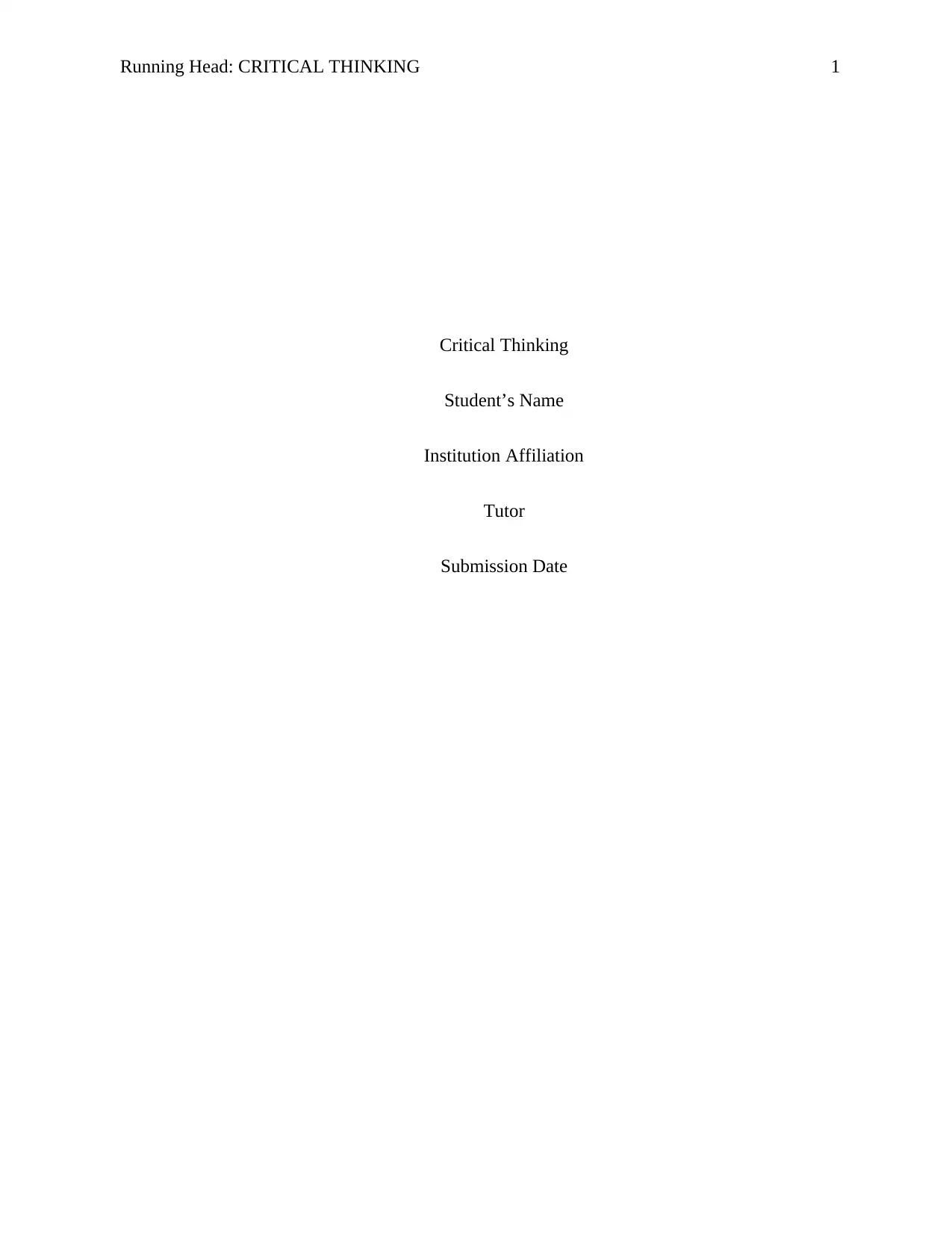
Running Head: CRITICAL THINKING 1
Critical Thinking
Student’s Name
Institution Affiliation
Tutor
Submission Date
Critical Thinking
Student’s Name
Institution Affiliation
Tutor
Submission Date
Paraphrase This Document
Need a fresh take? Get an instant paraphrase of this document with our AI Paraphraser
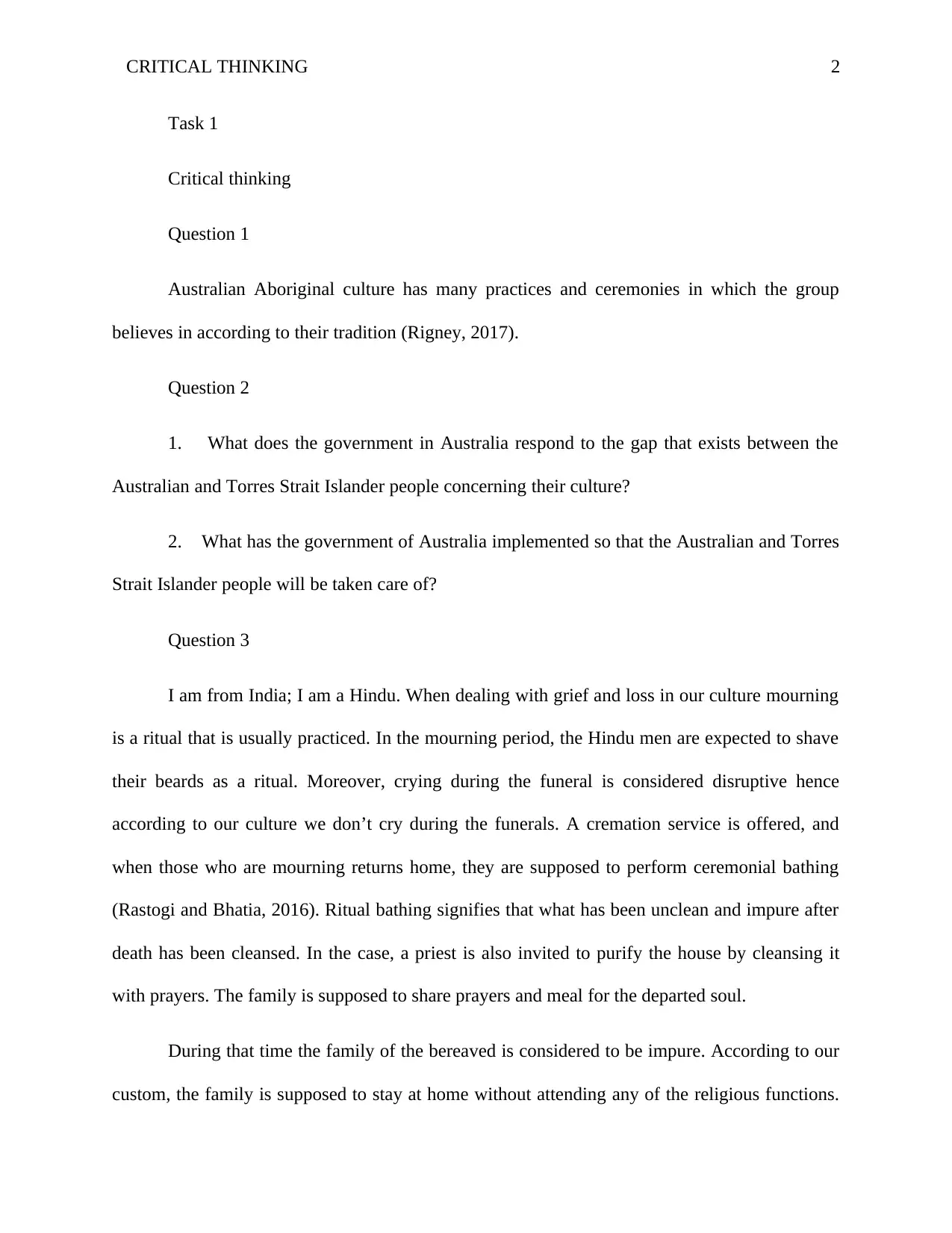
CRITICAL THINKING 2
Task 1
Critical thinking
Question 1
Australian Aboriginal culture has many practices and ceremonies in which the group
believes in according to their tradition (Rigney, 2017).
Question 2
1. What does the government in Australia respond to the gap that exists between the
Australian and Torres Strait Islander people concerning their culture?
2. What has the government of Australia implemented so that the Australian and Torres
Strait Islander people will be taken care of?
Question 3
I am from India; I am a Hindu. When dealing with grief and loss in our culture mourning
is a ritual that is usually practiced. In the mourning period, the Hindu men are expected to shave
their beards as a ritual. Moreover, crying during the funeral is considered disruptive hence
according to our culture we don’t cry during the funerals. A cremation service is offered, and
when those who are mourning returns home, they are supposed to perform ceremonial bathing
(Rastogi and Bhatia, 2016). Ritual bathing signifies that what has been unclean and impure after
death has been cleansed. In the case, a priest is also invited to purify the house by cleansing it
with prayers. The family is supposed to share prayers and meal for the departed soul.
During that time the family of the bereaved is considered to be impure. According to our
custom, the family is supposed to stay at home without attending any of the religious functions.
Task 1
Critical thinking
Question 1
Australian Aboriginal culture has many practices and ceremonies in which the group
believes in according to their tradition (Rigney, 2017).
Question 2
1. What does the government in Australia respond to the gap that exists between the
Australian and Torres Strait Islander people concerning their culture?
2. What has the government of Australia implemented so that the Australian and Torres
Strait Islander people will be taken care of?
Question 3
I am from India; I am a Hindu. When dealing with grief and loss in our culture mourning
is a ritual that is usually practiced. In the mourning period, the Hindu men are expected to shave
their beards as a ritual. Moreover, crying during the funeral is considered disruptive hence
according to our culture we don’t cry during the funerals. A cremation service is offered, and
when those who are mourning returns home, they are supposed to perform ceremonial bathing
(Rastogi and Bhatia, 2016). Ritual bathing signifies that what has been unclean and impure after
death has been cleansed. In the case, a priest is also invited to purify the house by cleansing it
with prayers. The family is supposed to share prayers and meal for the departed soul.
During that time the family of the bereaved is considered to be impure. According to our
custom, the family is supposed to stay at home without attending any of the religious functions.
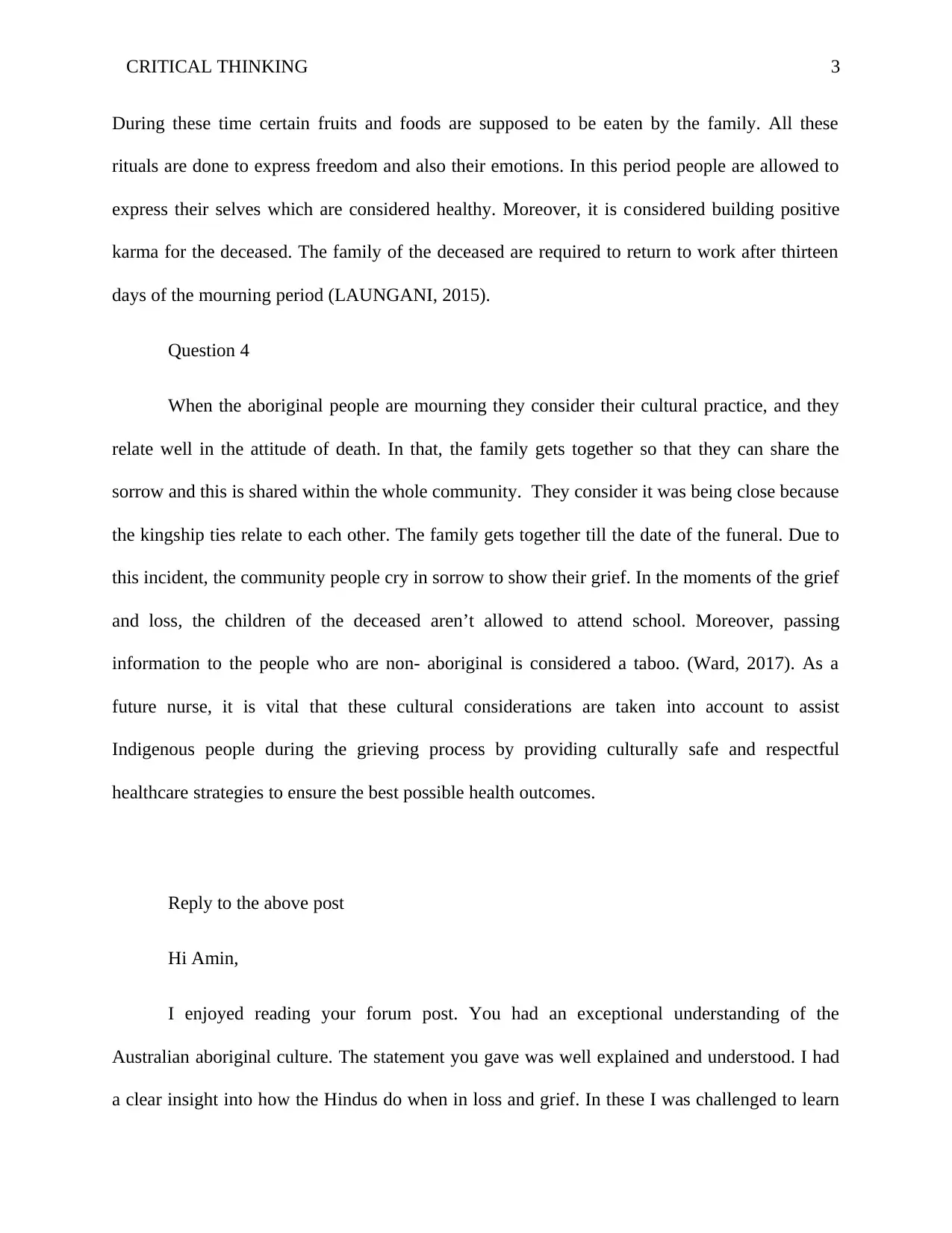
CRITICAL THINKING 3
During these time certain fruits and foods are supposed to be eaten by the family. All these
rituals are done to express freedom and also their emotions. In this period people are allowed to
express their selves which are considered healthy. Moreover, it is considered building positive
karma for the deceased. The family of the deceased are required to return to work after thirteen
days of the mourning period (LAUNGANI, 2015).
Question 4
When the aboriginal people are mourning they consider their cultural practice, and they
relate well in the attitude of death. In that, the family gets together so that they can share the
sorrow and this is shared within the whole community. They consider it was being close because
the kingship ties relate to each other. The family gets together till the date of the funeral. Due to
this incident, the community people cry in sorrow to show their grief. In the moments of the grief
and loss, the children of the deceased aren’t allowed to attend school. Moreover, passing
information to the people who are non- aboriginal is considered a taboo. (Ward, 2017). As a
future nurse, it is vital that these cultural considerations are taken into account to assist
Indigenous people during the grieving process by providing culturally safe and respectful
healthcare strategies to ensure the best possible health outcomes.
Reply to the above post
Hi Amin,
I enjoyed reading your forum post. You had an exceptional understanding of the
Australian aboriginal culture. The statement you gave was well explained and understood. I had
a clear insight into how the Hindus do when in loss and grief. In these I was challenged to learn
During these time certain fruits and foods are supposed to be eaten by the family. All these
rituals are done to express freedom and also their emotions. In this period people are allowed to
express their selves which are considered healthy. Moreover, it is considered building positive
karma for the deceased. The family of the deceased are required to return to work after thirteen
days of the mourning period (LAUNGANI, 2015).
Question 4
When the aboriginal people are mourning they consider their cultural practice, and they
relate well in the attitude of death. In that, the family gets together so that they can share the
sorrow and this is shared within the whole community. They consider it was being close because
the kingship ties relate to each other. The family gets together till the date of the funeral. Due to
this incident, the community people cry in sorrow to show their grief. In the moments of the grief
and loss, the children of the deceased aren’t allowed to attend school. Moreover, passing
information to the people who are non- aboriginal is considered a taboo. (Ward, 2017). As a
future nurse, it is vital that these cultural considerations are taken into account to assist
Indigenous people during the grieving process by providing culturally safe and respectful
healthcare strategies to ensure the best possible health outcomes.
Reply to the above post
Hi Amin,
I enjoyed reading your forum post. You had an exceptional understanding of the
Australian aboriginal culture. The statement you gave was well explained and understood. I had
a clear insight into how the Hindus do when in loss and grief. In these I was challenged to learn
⊘ This is a preview!⊘
Do you want full access?
Subscribe today to unlock all pages.

Trusted by 1+ million students worldwide
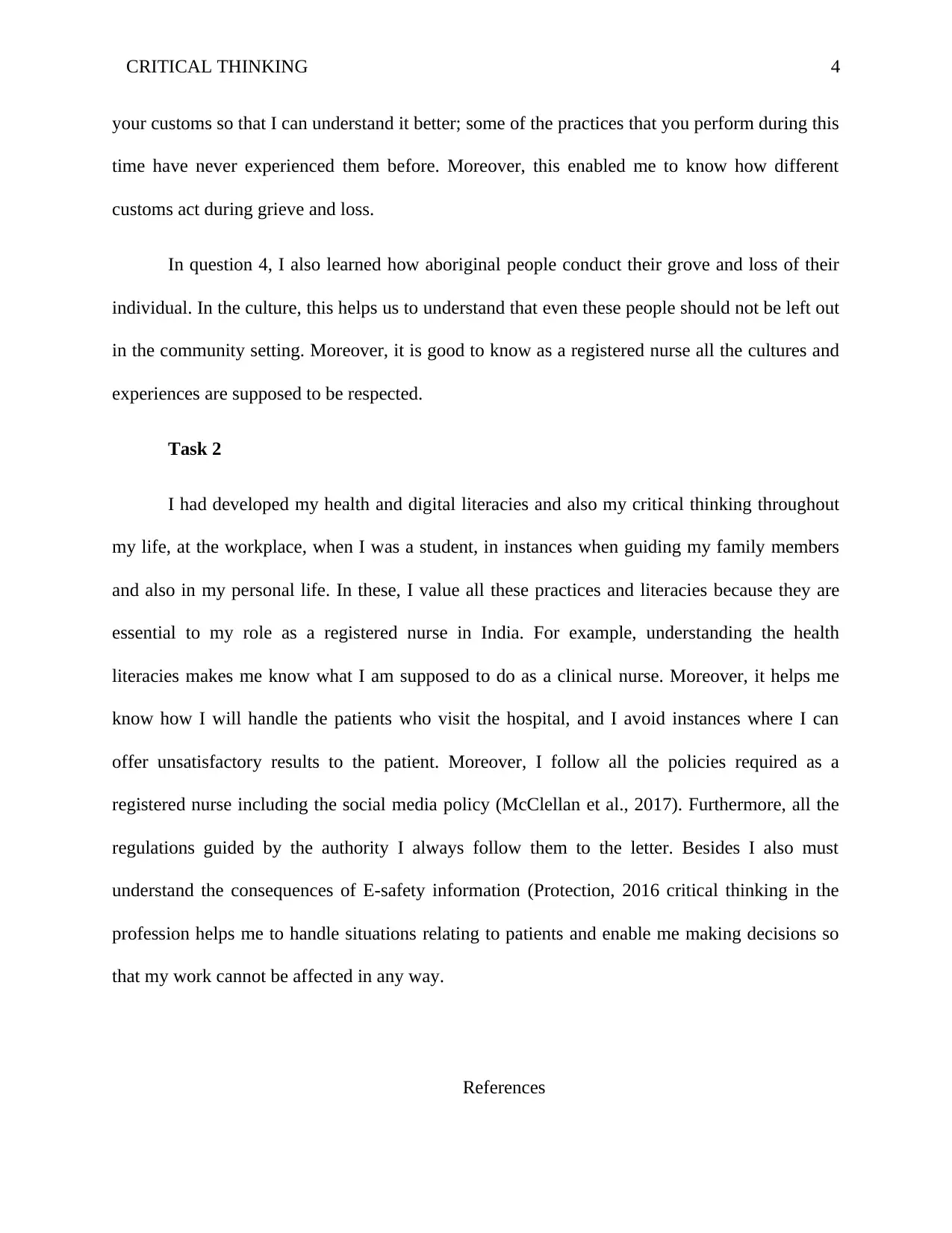
CRITICAL THINKING 4
your customs so that I can understand it better; some of the practices that you perform during this
time have never experienced them before. Moreover, this enabled me to know how different
customs act during grieve and loss.
In question 4, I also learned how aboriginal people conduct their grove and loss of their
individual. In the culture, this helps us to understand that even these people should not be left out
in the community setting. Moreover, it is good to know as a registered nurse all the cultures and
experiences are supposed to be respected.
Task 2
I had developed my health and digital literacies and also my critical thinking throughout
my life, at the workplace, when I was a student, in instances when guiding my family members
and also in my personal life. In these, I value all these practices and literacies because they are
essential to my role as a registered nurse in India. For example, understanding the health
literacies makes me know what I am supposed to do as a clinical nurse. Moreover, it helps me
know how I will handle the patients who visit the hospital, and I avoid instances where I can
offer unsatisfactory results to the patient. Moreover, I follow all the policies required as a
registered nurse including the social media policy (McClellan et al., 2017). Furthermore, all the
regulations guided by the authority I always follow them to the letter. Besides I also must
understand the consequences of E-safety information (Protection, 2016 critical thinking in the
profession helps me to handle situations relating to patients and enable me making decisions so
that my work cannot be affected in any way.
References
your customs so that I can understand it better; some of the practices that you perform during this
time have never experienced them before. Moreover, this enabled me to know how different
customs act during grieve and loss.
In question 4, I also learned how aboriginal people conduct their grove and loss of their
individual. In the culture, this helps us to understand that even these people should not be left out
in the community setting. Moreover, it is good to know as a registered nurse all the cultures and
experiences are supposed to be respected.
Task 2
I had developed my health and digital literacies and also my critical thinking throughout
my life, at the workplace, when I was a student, in instances when guiding my family members
and also in my personal life. In these, I value all these practices and literacies because they are
essential to my role as a registered nurse in India. For example, understanding the health
literacies makes me know what I am supposed to do as a clinical nurse. Moreover, it helps me
know how I will handle the patients who visit the hospital, and I avoid instances where I can
offer unsatisfactory results to the patient. Moreover, I follow all the policies required as a
registered nurse including the social media policy (McClellan et al., 2017). Furthermore, all the
regulations guided by the authority I always follow them to the letter. Besides I also must
understand the consequences of E-safety information (Protection, 2016 critical thinking in the
profession helps me to handle situations relating to patients and enable me making decisions so
that my work cannot be affected in any way.
References
Paraphrase This Document
Need a fresh take? Get an instant paraphrase of this document with our AI Paraphraser
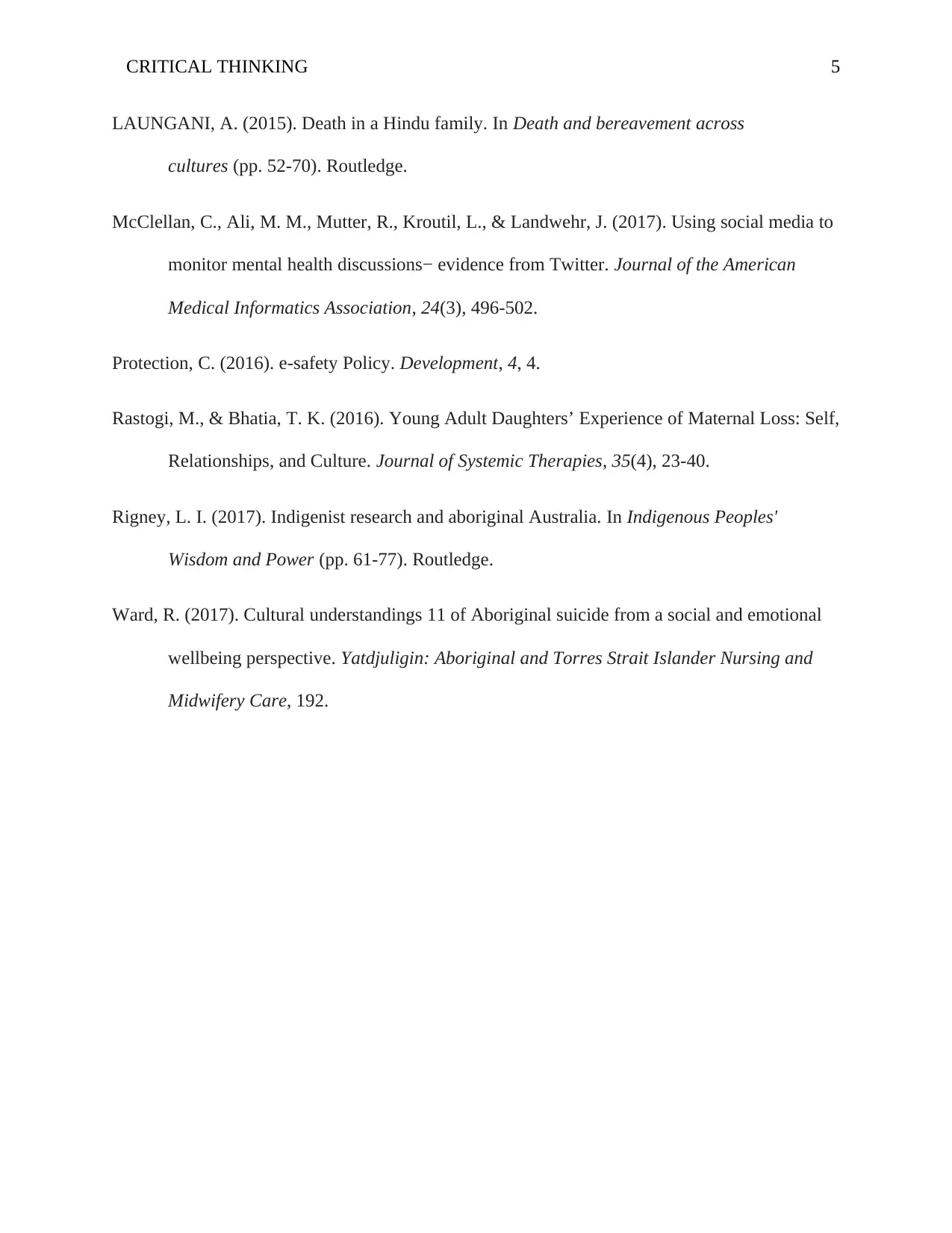
CRITICAL THINKING 5
LAUNGANI, A. (2015). Death in a Hindu family. In Death and bereavement across
cultures (pp. 52-70). Routledge.
McClellan, C., Ali, M. M., Mutter, R., Kroutil, L., & Landwehr, J. (2017). Using social media to
monitor mental health discussions− evidence from Twitter. Journal of the American
Medical Informatics Association, 24(3), 496-502.
Protection, C. (2016). e-safety Policy. Development, 4, 4.
Rastogi, M., & Bhatia, T. K. (2016). Young Adult Daughters’ Experience of Maternal Loss: Self,
Relationships, and Culture. Journal of Systemic Therapies, 35(4), 23-40.
Rigney, L. I. (2017). Indigenist research and aboriginal Australia. In Indigenous Peoples'
Wisdom and Power (pp. 61-77). Routledge.
Ward, R. (2017). Cultural understandings 11 of Aboriginal suicide from a social and emotional
wellbeing perspective. Yatdjuligin: Aboriginal and Torres Strait Islander Nursing and
Midwifery Care, 192.
LAUNGANI, A. (2015). Death in a Hindu family. In Death and bereavement across
cultures (pp. 52-70). Routledge.
McClellan, C., Ali, M. M., Mutter, R., Kroutil, L., & Landwehr, J. (2017). Using social media to
monitor mental health discussions− evidence from Twitter. Journal of the American
Medical Informatics Association, 24(3), 496-502.
Protection, C. (2016). e-safety Policy. Development, 4, 4.
Rastogi, M., & Bhatia, T. K. (2016). Young Adult Daughters’ Experience of Maternal Loss: Self,
Relationships, and Culture. Journal of Systemic Therapies, 35(4), 23-40.
Rigney, L. I. (2017). Indigenist research and aboriginal Australia. In Indigenous Peoples'
Wisdom and Power (pp. 61-77). Routledge.
Ward, R. (2017). Cultural understandings 11 of Aboriginal suicide from a social and emotional
wellbeing perspective. Yatdjuligin: Aboriginal and Torres Strait Islander Nursing and
Midwifery Care, 192.
1 out of 5
Your All-in-One AI-Powered Toolkit for Academic Success.
+13062052269
info@desklib.com
Available 24*7 on WhatsApp / Email
![[object Object]](/_next/static/media/star-bottom.7253800d.svg)
Unlock your academic potential
Copyright © 2020–2025 A2Z Services. All Rights Reserved. Developed and managed by ZUCOL.